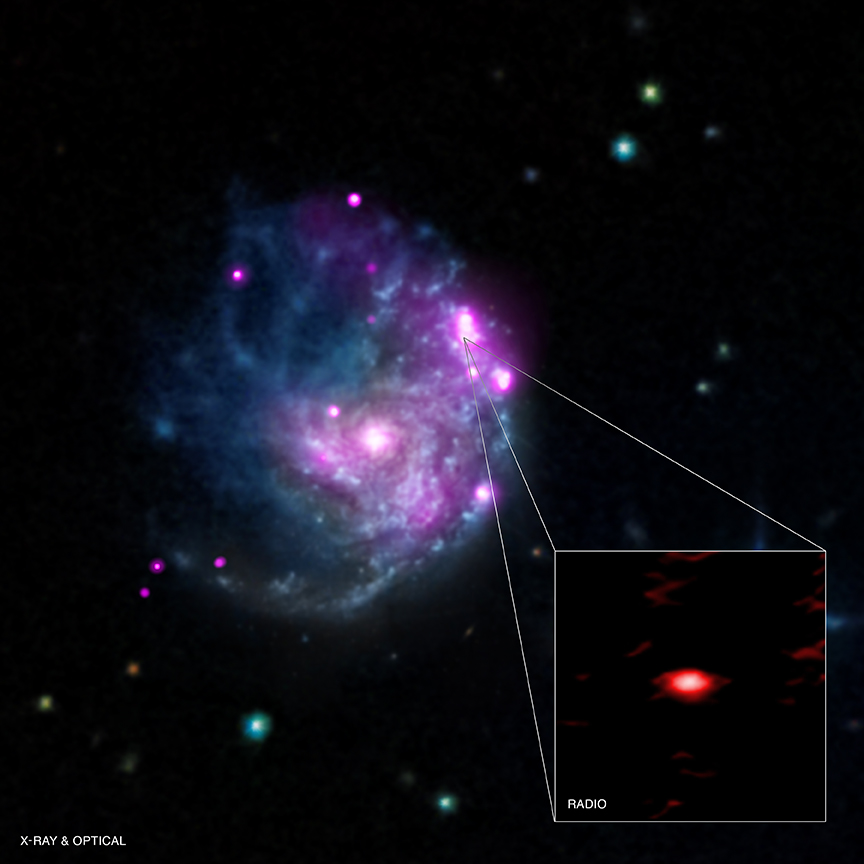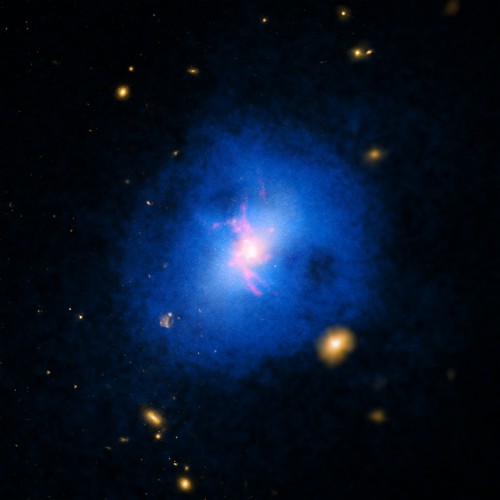
NASA’s Chandra X-ray Observatory continues to unfold the secrets of the universe for researchers, astronomers, scientists, and space enthusiasts alike. Last week, it was revealed in two papers that an object discovered in one of the spiral arms of galaxy NGC 2276, called NGC2276-3c—described as an “intermediate-mass black hole” (IMBH)—may explain the behavior of black holes, and how they influence their surroundings. These papers used X-ray data gleaned from the observatory. Another study published in the latest issue of Nature uses Chandra data to discuss the phenomenon of “cosmic precipitation.” NASA’s flagship X-ray observatory, part of its “Great Observatories” program, will soon enter its 16th year of operation, having only been slated to have a lifetime of five years.
The IMBH, NGC2276-3c, was discussed in two studies; one was written by Anna Wolter of the National Institute for Astrophysics (INAF) in Milan, Italy, and her colleagues, while one was written by Mar Mezcua of the Harvard-Smithsonian Center for Astrophysics, with colleagues. While Wolter’s paper discusses ultra-luminous X-ray sources (ULXs) and the possible origins of IMBHs, Mezcua’s study discusses NGC2276-3c at length, as it falls between the size range of smaller black holes that contain five to 30 times the mass of the Sun, and super-massive black holes that contain millions to perhaps billions of masses equivalent to the Sun. It has been suggested that IMBHs may be the originators of the super-massive black holes.
According to NASA, researchers studied NGC2276-3c “at almost the same time in X-rays with Chandra and in radio waves with the European Very Long Baseline Interferometry (VLBI) Network. The X-ray and radio data, along with an observed relation between radio and X-ray luminosities for sources powered by black holes, were used to estimate the black hole’s mass. A mass of about 50,000 times that of the sun was obtained, placing it in the range of IMBHs.” In addition, what has been described as a “powerful radio jet” extending up to 2,000 light-years was observed; the region within 1,000 light-years of the object shows an absence of young stars, which leads to the theory that the cavity carved out by gases in the jet may have played a role in suppressing star formation.

In addition to shedding some light upon the subject of intermediate-sized black holes, Chandra has also aided researchers in studying the phenomenon known as “cosmic precipitation,” which occurs when hot gases lead to clouds of cool gases sending “showers” into a galaxy.
Mark Voit of Michigan State University (MSU) in East Lansing, lead author of the paper published in Nature (a pre-print of the article can be found here), related: “We know that precipitation can slow us down on our way to work. Now we have evidence that it can also slow down star formation in galaxies with huge black holes.”
NASA stated further: “The answer appears to lie with the super-massive black holes at the centers of the large galaxies. Under specific conditions, clumps of gas can radiate away their energy and form cool clouds that mix with surrounding hot gas. Some of these clouds form stars, but others rain onto the super-massive black hole, triggering jets of energetic particles that push against the falling gas and reheat it, preventing more stars from forming. This cycle of cooling and heating creates a feedback loop that regulates the growth of the galaxies.”
In addition, researchers have located galaxies where this phenomenon “shut off,” perhaps due to heat from collisions with other galaxy clusters.
Data from Chandra has yielded other incredible stellar discoveries in the recent past. In January, AmericaSpace’s Leonidas Papadopoulos wrote, “Chandra’s long exposure time of a total of 380,000 seconds, or 4.5 days’ worth of observations, allowed scientists to study the X-ray emission of the Gioiello Cluster’s intracluster medium and determine that, despite its relatively young age of approximately 800 million years, the cluster’s overall mass was a staggering 400 trillion times the mass of the Sun, making it the most massive galaxy cluster discovered to date, surpassing the mass of such previous record-holders like the El Gordo Cluster.”
In October last year, a previous AmericaSpace article discussed the effect of turbulent black holes upon the formation of galaxies: “Chandra observed several galaxy clusters including Perseus and Virgo … which are swathed in gas clouds; at the center of these galaxies, large black holes are apparent. The chaotic interaction of the gas and the black holes are believed to have caused these galaxies to prevent forming many stars. Perseus and Virgo were targeted specifically because of their brightness and size.”
Chandra is managed by NASA’s Marshall Spaceflight Center in Huntsville, Ala., and is controlled by the Smithsonian Astrophysical Observatory in Cambridge, Mass. Deployed from Space Shuttle Columbia in July 1999 during the STS-93 mission (commanded by Eileen Collins, the first woman to command a space shuttle mission), it will enter its 16th year of operation this summer, and will undoubtedly lead researchers to more breakthroughs concerning the Universe we all live in.
Want to keep up-to-date with all things space? Be sure to “Like” AmericaSpace on Facebook and follow us on Twitter: @AmericaSpace



